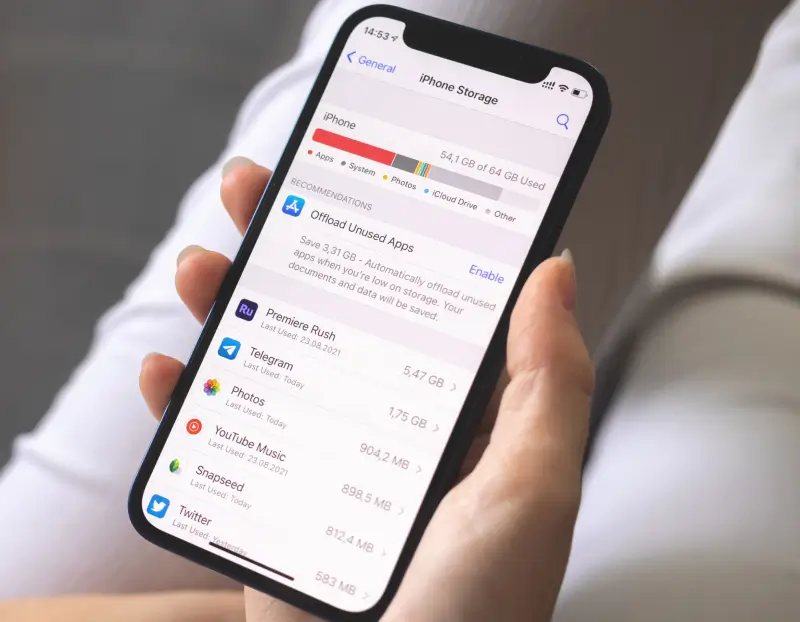Over time, iPhones can accumulate a substantial amount of system data, which may include cache files, logs, and other residual data from apps and system processes. This data not only consumes valuable storage space but can also affect the iPhone's speed and efficiency. Regularly cleaning up this data helps free up storage space, leading to improved device performance and an enhanced user experience. Secure Data Recovery experts, specialists in iPhone data recovery, provide a detailed guide on safely deleting system data on your device.
Understanding iPhone System Data
System data on an iPhone encompasses a range of files and information essential for the iOS operating system and various apps to function correctly. This category includes system files, temporary files, caches, logs, and other data types generated during the regular use of the device. While some of this data is crucial for the smooth operation of the iPhone and installed apps, other parts can be categorized as expendable.

Necessary system data comprises the core components of iOS, app executables, and files required for the basic functionalities of the iPhone and its apps. This data is vital for the stability and performance of the system and should not be tampered with indiscriminately. Examples include system firmware, security files, and configuration files that define how iOS and apps operate. Fortunately, it is almost impossible to accidentally delete this essential data.
On the other hand, expendable system data includes items like cache files and temporary files. Cache files are created by apps and the system to speed up processes and reduce loading times. While beneficial in enhancing performance, these files can accumulate over time, occupying unnecessary storage space. Temporary files, created during app or update installation or when apps perform certain tasks, may not always be deleted automatically, leading to inefficient use of storage space.
It is helpful to understand the difference between necessary and expendable system data for safe management of the iPhone's storage. While iOS generally manages expendable system data well, it is sometimes helpful to manually clear it when it begins occupying more space than it needs.
Simple Steps to Reduce System Data Usage

To minimize the amount of storage occupied by system data, users should begin with the following measures:
- Update iOS: Regularly updating the iPhone to the latest version of iOS can help. System updates not only bring new features and security patches but also optimize and sometimes reduce the space taken by system files. To update, navigate to Settings, select General, and then Software Update.
- Offloading Unused Apps: iPhones offer a feature to automatically offload apps that are infrequently used. Offloading an app removes it from the device but retains its data, reducing the overall storage footprint. This feature can be enabled in Settings under the iTunes & App Store section.
- Reviewing and Deleting Unnecessary Data: Manually check for data that may not be needed, such as large downloaded files in apps, old messages, and email attachments. Removing these has the potential to slightly decrease system data.
- Restart: A simple restart of the iPhone can sometimes clear temporary files contributing to system data. To restart, hold down the Power button and the home button or the power button and either volume button on newer models, slide to power off, and then turn the device back on. This can help in releasing some of the storage space temporarily held by system processes.
Other methods, such as managing app data, photos, emails, or Safari cache, are useful for general storage management but may not have a substantial impact on the "System Data" section specifically. For persistent or unexplained high usage in system data, seek professional assistance. As part of the Apple Authorized Service Provider Program, our iPhone experts can often diagnose and address the issue without putting important data at risk.
Factory Resets and Other Options
“System Data” can be somewhat opaque in terms of what exactly it encompasses and how much you can reduce its size. Typically, this category includes caches, logs, and other system files that are necessary for the smooth operation of the iOS. While some temporary files within system data can be cleared with a device restart or iOS update, a significant portion of this category is essential for the iOS to function properly and can't be manually cleared or reduced significantly without actions like a factory reset.
If system data remains stubbornly high, a factory reset might be the only remaining option. This action erases all content and settings from the iPhone, so it is imperative to back up important data first. To perform a factory reset, go to Settings, select General, Reset, and then choose Erase All Content and Settings.
Remember: This should only be used as a last resort after ensuring all valuable data is backed up.
If system data continues to be excessively large following a factory reset and restore, it is likely contained within the backup used for restoration. This is a more complex issue and it may be time to seek professional assistance.
Still Need Help? Give Us a Call
Secure Data Recovery specializes in addressing such intricate problems. With our expertise in Apple data recovery and iPhone system management, we can provide solutions for cases where system data remains inexplicably high. Our team can help diagnose and resolve underlying issues contributing to excessive system data usage.
Managing system data on an iPhone requires a balance between the necessary system operations and efficient storage usage, and while the operating system usually undertakes this process itself, sometimes it is necessary to intervene. By following these steps, most users can effectively reduce the system data portion of their storage to some degree. However, in instances where these steps are not sufficient, Secure Data Recovery offers a reliable avenue for resolving more persistent storage issues.









